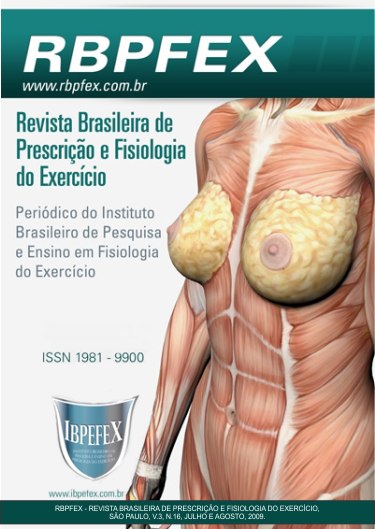Physical exercises aerobic prescription: TIIA, a practical tool
Abstract
The first ventilatory threshold (LV1) and the second ventilatory threshold (LV2), which can be derived from the Ventilometrcs, have been proposed as markers of ability and as a reference for prescription of resistance training in aerobic exercises. The purpose of this study was to compare the values of the loads of work on the intensities of these thresholds found in Ventilometrics with the TIIA of individuals belonging to panels of three academies of the great Natal. Methods: 20 subjects with 11 females and 9 males. These individuals were subjected to a test of maximum effort in order to determine the Ventilometrics FCmax, the LV1, and LV2. And the sub in the Test Identification of intensities Aerobics (TIIA) to determine Intensidade1 (I1) and Intensidade2 (I2). In ventilometrics the LV1 was established by the software and LV2 was identified in the intensity of physical effort in which the VE predecessor progressive increases in the second exponential curve. The value of FCmax was considered the largest obtained in the test. TIIA in the I1 and I2 have been identified by stabilizing the FC train (equation of Karvonen) respectively in the upper and lower limit. The LV1 and I1, I2 and the LV2 were correlated in a chart depending on the workload. Results: There were no significant differences in the means of loads of work: the LV1 (average 5.4 km / h) and I1 (average 6.2 km / h), and the LV2 (average 7.3 km / h) and I2 (average 7.4 km / h) among the tested. It was concluded that more studies are needed to ensure that the TIIA is validated, because a larger sample would this validation.
References
- Brunetto, Antônio F.; Moreira, Bruno S.; Tesini, Bruno R; Muller, Daniel H. e Guedes, Dartagnan P. Limiar ventilatório e variabilidade da freqüência cardíaca em adolescentes Rev Bras Med Esporte _ Vol. 11, Nº 1 – Jan/Fev, 2005.
- Karvonem, M.J.; Kentala, E.; Mustala, O. The effects of training on heart rate: a longitudinal study. Ann Med Exper Fenn. Vol. 35. Num. 3. 1957. p. 307 – 315.
- Nakamura, F.Y.; Muller, D.H.; Borges, T.O.; Okano, A.H.; Oliveira, F.R.; Brunetto, A.F. Relação entre indicadores fisiológicos obtidos em teste ergoespirométrico em cicloergômetro de membros superiores e desempenho na canoagem. Rev Bras Med Esporte _ Vol. 13, Nº 5 – Set /Out, 2007.
- Negrão, C.E.; Barreto, A.C.P. Cardiologia do Exercício: do atleta ao cardiopata. 2 ed. Ver. e ampl. Barueri – S.P.: Manole, 2006.
- Porpino, S.K.P.; Brito, A.F.; Almeida, D.L.; Santos, M.A.P. Comparação das respostas ao exercício de caminhada pelo método de zona alvo e escala de Borg. Universidade Federal da Paraíba. Joao Pessoa, Paraíba 2008.
- Simão, Roberto. Fisiologia e Prescrição de exercícios para grupos especiais. 2 ed. São Paulo - Phorte Editora, 2006.
- Yazbek, P.Jr.; Tavares, R. C.; Sabbag, L.M.S.; Rizzo, L.B. Ergoespirometria. Teste de Esforço Cardiopulmonar, Metodologia e Interpretação. São Paulo, SP Arq Bras Cardiologia _ Vol 71, Nº 5, 1998.
Authors who publish in this journal agree to the following terms:
- Authors retain the copyright and grant the journal the right of first publication, with work simultaneously licensed under the Creative Commons Attribution License BY-NC which allows the sharing of the work with acknowledgment of the authorship of the work and initial publication in this journal.
- Authors are authorized to enter into additional contracts separately for non-exclusive distribution of the version of the work published in this journal (eg, publishing in institutional repository or book chapter), with acknowledgment of authorship and initial publication in this journal.
- Authors are allowed and encouraged to post and distribute their work online (eg, in institutional repositories or on their personal page) at any point before or during the editorial process, as this can bring about productive change as well as increase impact and impact. citation of published work (See The Effect of Free Access).






